
Designed by Bertram Goodhue in the Perpendicular Gothic style, this church emphasizes verticality. We also have pictures of the interior of First Baptist.

Designed by Bertram Goodhue in the Perpendicular Gothic style, this church emphasizes verticality. We also have pictures of the interior of First Baptist.
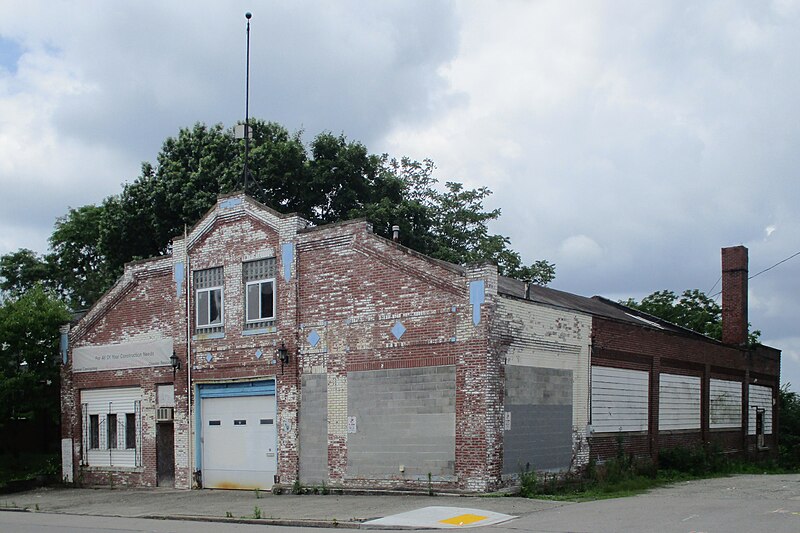
Now it belongs to a contractor, and the filling-in with concrete blocks and artificial siding is probably a fair sample of a Pittsburgh contractor’s taste. But the building is, on the whole, in an excellent state of preservation. It shows up on our 1923 map as the Horst & Mooney Garage, and we can probably guess what brand of cars it sold and serviced.
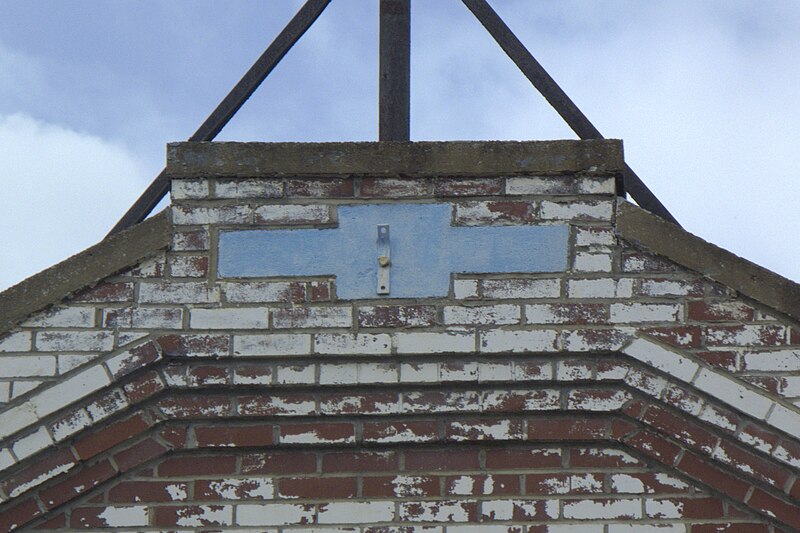
Update: Mr. John Hempel has pointed out that this was a Packard dealer in 1930. “In your fascinating Car Dealers page, Horst & Mooney may have been a Chev dealer more recently, but it was originally a Packard dealer. Pitt archives has a photo – just search Horst & Mooney.”
Many thanks to Mr. Hempel for pointing out the old photograph. Here is the picture he mentions, and the signs certainly leave no doubt about what cars this dealer was selling:

You can see a very-high-resolution scan at the Historic Pittsburgh site. Because the resolution is so high, we can see that the little decoration at the peak of the roof was there from the beginning:

It is possible that this is not meant to be a Chevrolet logo, but both the shape and the blue color seem hard to mistake.

So Father Pitt’s working hypothesis is that this was a Chevrolet dealer before it was a Packard dealer, but the well-to-do Brighton Heights clientele justified moving up in the world.
The 1930 photo gives us a good look at the original state of the building and confirms that, except for the filling-in of windows, it has not changed very much. As a bonus, we also get a good look at the California Methodist Episcopal Church and, right at the corner of the garage lot, a streetcar shelter.

The 2100 block of Sidney Street has some of the finest high-Victorian houses on the South Side, and several of them have unusual decorative details worth a closer examination. Old Pa Pitt took an evening stroll down Sidney Street the other day and, as always, came back with a few pictures. We’ll start with No. 2109. Note the multiple shapes of roof slates, the woodwork in the dormers, and the rusticated lintels in the picture above.
Since we have fifteen pictures, we’ll put the rest below the fold to avoid slowing down the main page for a week.
(more…)
A fine example of Tudor Gothic applied to a small church. This is one of the decreasing number of churches in Homestead still inhabited by their original congregations. It is also one of the few churches dedicated to St. Mark the Evangelist that give us his full name.
Note the tidy little Tudor parsonage in the rear.
Addendum: The architect was Andrew Lisle; the church and parsonage were designed together in 1916 (and therefore probably finished in 1917). Source: “Gets Contract for Church in Pitcairn,” Pittsburg Press, August 6, 1916. “Bids have been received and are now under consideration by architects and owners as follows:… for a church and parsonage for the St. John’s Lutheran congregation at Homestead, Andrew Lisle, Architect…”

Architect William P. Hutchins certainly made the most of the site. He had a hillside location, a prominent intersection, and a lot of space to work with, so he oriented the building diagonally and gave the church a west front (liturgically speaking) that hits us with an outsized magnificence as we come up California Avenue. The church was built in 1927; the style is Perpendicular Gothic, and already shows some signs of the streamlining that would mark Hutchins’ later works. (To see how far he would take that streamlining, have a look at Resurrection Church in Brookline, one of Hutchins’ last churches.)



Shields in relief over the three main doors honor important saints with their symbolic attributes.



The cornerstone. The Latin inscription says, “This is the house of God and the gate of heaven.”

Old Pa Pitt noticed that Wikimedia Commons had no current pictures of landmarks in the very pleasant neighborhood of Brighton Heights, except for a few pictures of the Sacrifice monument, most of them taken by Father Pitt. That lacuna has now been filled, and we will be seeing many of the pictures in the next couple of weeks.

These tiny houses at the corner of 24th Street and Carey Way were probably built as rental properties, meant to be the cheapest possible construction that could still be rented as a “house” rather than a tenement. They are what old Pa Pitt might call Baltimore-style rowhouses, where the whole row was built as one building, although in Baltimore the building would typically cover a whole block. The ones on 24th street were built between 1903 and 1910; the ones around the corner on Carey Way were built between 1910 and 1923. Yet we notice that, in those days, even these utilitarian shoeboxes for poor millworkers were not allowed to show their faces in public without a proper ornamental cornice.

This is also an excellent view of a typical Pittsburgh system of utility cables.



What this remarkable and slightly fantastical rectory needs is a nice church to go with it, but St. Peter’s was demolished several years ago. The rectory, however, has been restored and sensitively updated.
The architectural style is a Gothic fantasy that even includes some Moorish-looking decorations. The emphatic vertical in the front creates the impression of a tower without exactly being a tower.


These are all high-dynamic-range pictures, each made from three different photographs at different exposures.
Since the clouds were picturesquely textured that day, old Pa Pitt thought he might try the effect of black-and-white pictures with a (simulated) red filter to bring out the clouds. The results are worth seeing, if you care to continue.
(more…)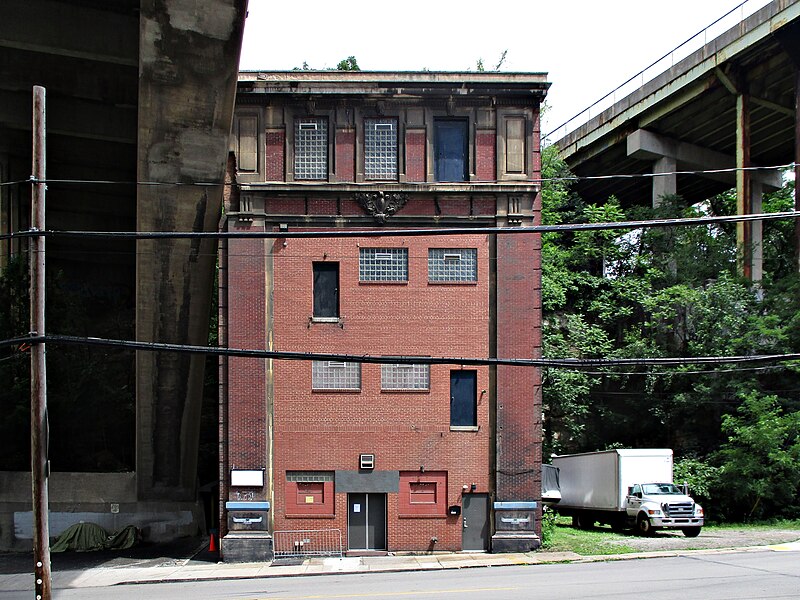
Addendum: Note the comment from David Schwing below, citing the definitive book on Scheibler, which old Pa Pitt really needs to add to his library:
According to Martin Aurand in “The Progressive Architecture of Frederick G. Scheibler, Jr.” this building was built in 1902 for Robert L. Matthews. This predates the Ohio Boulevard Bridge to the left of the building.
This makes the building one of Scheibler’s early works; he had left Longfellow, Alden & Harlow in 1898, and apparently carried some of that illustrious firm’s classical aesthetic with him. Many thanks to Mr. Schwing for the information.
Another addendum: The building was the Robert L. Matthews Departments Store, according to an Architects Tour Program from the Allegheny City Society.
The original article is below.
Down in the Woods Run valley, crammed between the Ohio River Boulevard bridge on the one side and the California Avenue bridge on the other, is this strange building, obviously much altered over the years, which once belonged to the Kazimier Pulaski Society. What makes it even more fascinating is that a city architectural survey identifies it as the work of Frederick Scheibler, one of the most interesting early modernist architects in Pittsburgh.
The building seems to be in use by a “social club,” which as old Pa Pitt understands it differs from a “bar” in that it closes at 3 a.m. instead of 2 a.m. A building permit for alterations to the second-floor interior was issued in October and is still taped to the door.

You may have noticed the doors to nowhere on the second, third, and fourth floors. We can only assume that a fire escape was installed on the front of this building at some time in its history, or possibly balconies. At least we hope that is what those doors indicate. (Update: A reader points out that the fire escape was present as recently as 2017 and can be seen in earlier layers of Google Street View.)

Although the details of most of the front have disappeared, the interesting treatment of the fourth floor is mostly preserved.
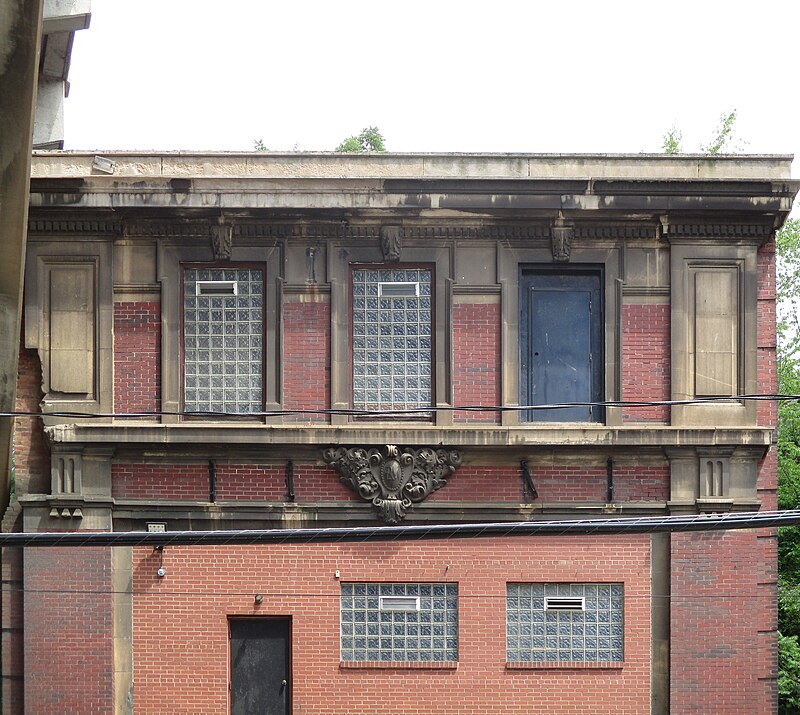

The monogram “RLM,” or possibly “LRM,” in this cartouche suggests that the Kazimier Pulaski Society was not the original builder.
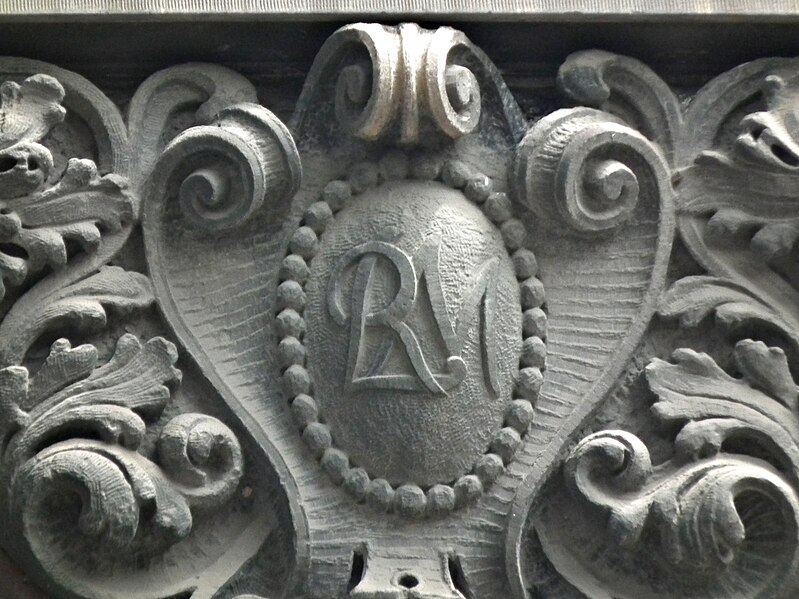


This Queen Anne house in McKeesport is probably doomed as soon as the city has the budget to demolish it. Something could be made of it, but it would take a complete reconstruction of the interior, and in a city where the median property value is about $20,000 that is not likely to happen. In Shadyside, it could be profitably restored, but not in McKeesport.
Google Street View shows this house in the same condition as far back as 2007, the first year of Street View. Until recently, another equally decrepit and equally splendid Queen Anne house sat right next to this one, but it was demolished some time after Google Street View pictured it in 2019, possibly because someone was fixing up the baroque mansion on the other side.

This is an odd anomaly in a block of some of the finest houses on the South Side: a substantial brick house built as a kind of lean-to parasite on the house next door.
No. 2317 is set far back from the street, with a shaded porch—the only porch on the block—almost like a country house in the city. It clings dependently to the side of No. 2315 next door.

What was the reason for this unusual construction? Old maps may give us a clue. Both houses appear first on the 1890 layer of the Pittsburgh Historic Maps site, so they were built between 1882 and 1890. The larger one is marked as owned by a Wm. J. Early, and the set-back lean-to house by Annie E. Early. We can speculate that Mr. Early built a large main house for his own family, and a smaller one for a female relative—perhaps a widowed mother.